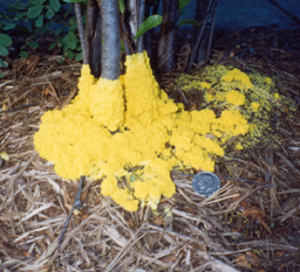Halloween in the backyard already? The story of slime molds

It may not be Halloween yet, but your yard might be as quick to put on some creature features of their own as fast as the dollar store puts out candy and autumn décor the day after Fourth of July.
As the weather cools, and you go out in the morning and find after just a few steps in the grass, your shoes are so wet from heavy dew it is as though you went swimming. You might also be finding some unusual visitors that seem, well let’s just say other-worldly. They are strange alien structures that weren’t there last night. They aren’t fun guys (fungi), but slime molds.
For our purposes, slime molds and mushrooms seem the same … Something you are just looking to get rid of in your grass or planting beds. Technically, and after all I am a science nerd, slime molds and mushrooms appear at the same time every year because of their need for similar environmental conditions to “fruit” (more on that later).
Slime molds for many years were considered part of the fungi world (in the class Myxomycetes). But they are different structurally; their cell walls are composed of cellulose, while for fungi the cell walls are composed of chitin. So now slime molds are part of the Kingdom Protista. Another interesting difference is slime molds engulf (surround) their food (bacteria) like an amoeba, whereas fungi digest food externally.
Now, out of the classroom and back to the yard where these oddities of nature are found. Slime molds tend to show up in certain types of weather conditions. Like all fungi, they are happiest in moist environments with temperatures are moderate. That is why we see them so much in the fall.
Depending on the type of spring Mother Nature hurls at us, we sometimes see slime molds then, too. But the weather has to be mild temperatures for this to happen. The last few springs should have been renamed winter-directly-into-summer as we could count the hours of moderate temperatures on one hand.
Every year I get lots of questions about two specific slime molds that seem to call Will County home. The most common one I get reports of is the dog vomit slime mold, Fuligo septica. This bright neon yellow slime mold often appears on mulch and scares the spores out of most homeowners.
It is a flat, kind of flaky yet gooey mass of mycelium and most often occurs on hardwood mulch. No matter how many times I tell homeowners that this is a good thing, most don’t “appreciate” that it just shows their mulch is working, breaking down.
Most people just want to know how to get rid of it, once and for good. They often say they want to get rid of it before it “spreads.” Do you want the good news, or the bad news? Well they are one in the same. Whether you “do” something or not, slime molds will happen and disappear on their own. Just like in the sci-fi movies.
 The late Dr. Tom Volk of University of Wisconsin-Madison, a world-renowned mycologist (one who studies fungi and related organisms), was great at sharing fun facts about all things spore-producing. His Fungus-of-the-Month that can still be found at https://botit.botany.wisc.edu/toms_fungi/ is a great mix of some serious scientific jargon as well as interesting factoids. Dr. Volk shared that the dog vomit slime mold was thought to be the inspiration for the 1958 horror movie, “The Blob.”
The late Dr. Tom Volk of University of Wisconsin-Madison, a world-renowned mycologist (one who studies fungi and related organisms), was great at sharing fun facts about all things spore-producing. His Fungus-of-the-Month that can still be found at https://botit.botany.wisc.edu/toms_fungi/ is a great mix of some serious scientific jargon as well as interesting factoids. Dr. Volk shared that the dog vomit slime mold was thought to be the inspiration for the 1958 horror movie, “The Blob.”
Remember, they arise due to certain environmental conditions, and once those conditions change, they disappear as though they had never been there.
The more effective thing to do to get rid of slime molds is to change the environment. Water them, rake them out to change the speed of mulch decomp.
The other slime mold I seem to get calls on and see more every year is one that is, well, somewhat embarrassing to describe. It is a somewhat grotesque pink/orangish stalk with a slimy cap (called a gliba) on it. And worst of all it smells like rot. Fun, huh? Just what you want in your landscape.
This is the dog stinkhorn fungus, Mutinus caninus. Since this is a polite column let’s just say it got this common name as the visual is of an excited male dog’s anatomy protruding from the soil. You should just hear the many ways people have tried to describe this to me. They hem and haw, and I finally save them by giving that description. Their relieved sigh and chuckle confirm.

Giant puffball mushroom
The start of the dog stinkhorn is equally strange. People report finding what look to be hard-boiled egg structures just below the soil. That is their pre-emergent, below ground state.
The dog stinkhorn has really increased in numbers literally popping up in garden beds, lawns, even raised planter boxes. Not only is the visual X-rated, but the odor the mature slime mold produces are described as a litter box that has not been cleaned for some time.
Just like with everything in nature, whether it is a magnificent blue butterfly or a smelly slime mold, it has a purpose. The smell of the dog stinkhorn attracts flies to spread its spores. Unlike the dog vomit slime mold that seems to have a crawling habit, this one is, well, erect, and is easily removed by scooping up into a bag and disposing.